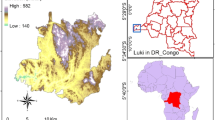Abstract
An internal household survey of socioeconomic indicators in the Cross River State forest communities showed that basic infrastructural facilities such as clean water supply, adequate waste disposal system, good roads and electricity are grossly inadequate. There is a total absence of modern family planning practices in the communities, and population is projected to increase by 44.8% between 2000 and 2015 and 85.4% between 2000 and 2025. The study revealed that about 65% of the population of the rainforest communities consists of subsistence farmers and power chain operators, and besides the 19% of the Cross River State Tropical High Forestry (THF) already reported to have been lost to agriculture and plantation between 1972 and 1991, about 9% was lost between 1991 and 2000. An additional 25% of the THF will be lost by 2025, leaving only 470600 hectares (4706 km2). With 84.1% of community members having an annual income less than $300, the survival potential of the Cross River State rainforest in the next fifty years is very low, unless an effective forest management programme is encouraged by government in partnership with all stakeholders.
Similar content being viewed by others
References
Agyei, Y.: 1998, ‘Deforestation in Sub-Saharan Africa.’ African Technology Forum, Vol. 8, No.1, Massachusetts Institute of technology.
Cadecott, J. O., Bennet, J. G. and Ruitenbeek, H. J. : 1989, ‘Cross River National Park,’ Oban Division; Plan for Developing the Park and its support zone. World Wide Fund Nature (WWF; Godalming).
Chidumayo, E. N. : 1997, ‘Woodfuel and Deforestation in Southern Africa—a misconceived association.’ Renewable Energy for Development. July 1997, Vol. 10, No. 2.
Dudik, D., Draper, K., Dickinson, E. and Dwyer, D. : 1999, ‘GEOG 3104: Environmental Problems, Population and Development,’ Fall Semester, 1999.
Dunn, R. and Otu, D. : 1994. ‘Reconnaissance Inventory of High Forest and Swamp Forest Areas in Cross River State, Nigeria.’ In: Towards the sustainable management and protection of Cross River State forest resources. A paper presented at a one-day workshop organized by Ukpim Inter-Continental Nig. Ltd., by Inah M. Inah, Cross River State Forestry Development Department, 1997.
Ebin, C. O. : 1991, ‘Resource Conservation and Sustainable Economic Development.’ The Cross River State National Park Approach. Trans. Nig. Soc. Biol. Conserv. 2,17–31.
Forestry Development Department : 1994, ‘A Strategy for Sustainable Development, Conservation and Management of The Forests of Cross River State, Nigeria (ODA Assisted), Cross River State.’ 30 pp.
FOS : 1985, ‘National Integrated Survey of Households (NISH): Report of General Household Survey (1982–1983).’ Federal Office of Statistics, Lagos.
FOS : 1995, ‘Annual Abstract of Statistics.’ Federal Office of Statistics, Lagos.
FOS : 1997, ‘Socio-Economic Profile of Nigeria, 1996.’ Federal Office of Statistics, Abuja.
FOS : 1999, ‘Poverty and Agricultural Sector in Nigeria.’ Federal Office of Statistics, Abuja.
GESAMP : 1997, ‘Marine Biodiversity: patterns, threats and conservation needs.’ GESAMP(IMO/FAO/UNESCO/WMO/WHO/ IAEA/UN/UNEP Joint Group of Experts on the Scientific Aspects of Marine Environmental Protection (GESAMP) 1997: Marine Biodiversity patterns, threats and conversation needs. GESAMP Reports and Studies No.62: 24 pp.
Gillis, M.: 1996, ‘Tropical Deforestation, Poverty, Population and Public Policy.’ A paper delivered to the 1996 Rice Environmental Conference, Rice University, February 2, 1996.
Hekstra, G.P. : 1982, ‘The Green Revolution Confronted with The World Conservation Strategy.’ Ecoscript 14. 37 pp.
Inah, M. I. : 1997, Roles of communities in Forest Reserves Management: A paper presented at the two-day training Workshop organized by FORMECU, Ibadan, on Community Participation in Forest Reserves Management, February, 1997.
Inah, M. I. : 1997, Towards the Sustainable Management and Protection of Cross River State Forest resources: A paper presented at a one-day Workshop organized by Ukpim Inter-Continental Nig. Ltd, 1997.
Maikhuri, R. K., Rao, K. S and Semwal, R. L. : 2001, ‘Changing scenario of Himalayan agroecosystems: loss of agrobiodiversity, an indicator of environmental change in Central Himalaya, India: The Environmentalist.’ 21(1), 23–39.
Ministry of Finance and Economic Planning : 1985, ‘Cross River and Akwa Ibom State Population Bulletin 1983–90. Ministry of Finance and Economic Planning, Statistics Division, Calabar.’ 146.
Myers, N and Kent, J. : 2001, ‘Food and Hunger in Sub-Saharan Africa.’ The Environmentalist. 21(1), 41–69.
NEST : 1991, ‘Nigeria's Threatened Environment: A National Profile.’ Nigerian Environmental Study / Action TEAM. The NEST Publication, Intec Printers Ltd., Ibadan. 288 pp.
Skoup and Company : 1986, ‘Feasibility Studies for National Forest Resources Survey.’ Federal Department of Forestry, Ibadan.
UNESCO : 1984, ‘Hydro-Environmental indices: A Review and Evaluation of their use in the Assessment of the Environmental Impacts of Water Projects.’ IHP-11 Project A 3.2. UNESCO, Paris. 179 pp.
Vanguard Media Limited, Apapa, Lagos, Tuesday, September 18, 2001. Controversy rages over Kenyan forest. P.50.
World Resources Institute: 1987, World Resources, 1987, New York: Basic Books. 375 pp.
Author information
Authors and Affiliations
Rights and permissions
About this article
Cite this article
Eja, M.E. Socioeconomic indicators and the survival of the tropical rainforest of cross river state of Nigeria. Environmentalist 26, 83–92 (2006). https://doi.org/10.1007/s10669-006-7478-9
Issue Date:
DOI: https://doi.org/10.1007/s10669-006-7478-9




